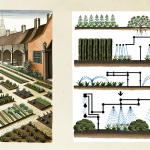Understanding Windbreaks and Shelterbelts
Windbreaks and shelterbelts are essential tools for creating a more controlled and productive garden environment. By understanding how these natural barriers work, you can effectively manage the wind, temperature, and overall microclimate of your garden, leading to healthier plants and better yields.
Benefits of Windbreaks and Shelterbelts
- Reducing Wind Speed: Windbreaks can decrease wind speed significantly, protecting delicate plants from wind damage.
- Preventing Soil Erosion: A well-placed windbreak minimizes soil erosion by reducing the force of wind on exposed soil surfaces.
- Moderating Temperature: These structures help moderate temperature extremes, keeping your garden warmer in the winter and cooler in the summer.
- Enhancing Moisture Retention: By reducing air movement, windbreaks help maintain soil moisture, which is crucial for plant health.
Choosing the Right Plants for Windbreaks
Selecting the appropriate plants for your windbreak or shelterbelt is key to its effectiveness. Consider the following:
Tall, Dense Trees and Shrubs
- Evergreens: Species like Norway spruce, leyland cypress, and arborvitae provide year-round protection.
- Deciduous Trees: Use trees such as poplar, willow, and maple, which grow quickly and provide ample coverage during the growing season.
Layered Planting
A diverse, layered approach ensures maximum protection. Plant a combination of tall trees, mid-sized shrubs, and low-growing plants to create a dense barrier.
Spacing and Placement
- Spacing: Dense planting ensures that wind is effectively slowed. Space trees and shrubs closely enough to create overlapping canopies.
- Orientation: Position your windbreak perpendicular to prevailing winds for maximum efficiency.
Maintaining Your Windbreak
Regular maintenance is crucial for the longevity and effectiveness of your windbreak. Follow these tips:
- Pruning: Regularly prune plants to encourage dense growth and remove any dead or diseased wood.
- Watering: Ensure that your windbreak receives adequate water, especially during dry periods.
- Mulching: Mulch around the base of plants to conserve moisture and suppress weeds.
- Monitoring: Keep an eye out for pests and diseases, and take swift action if any issues arise.
Additional Microclimate Management Techniques
Beyond windbreaks and shelterbelts, consider these microclimate management techniques:
Temperature and Humidity Control
- Row Covers: Use row covers to protect plants from frost and excessive heat.
- Shade Cloth: Install shade cloth to reduce temperature and protect plants from sunburn.
- Mist Systems: Implement misting systems to increase humidity and cool plants during hot weather.
Soil and Water Management
- Organic Mulch: Apply organic mulch to help regulate soil temperature and moisture.
- Drip Irrigation: Use drip irrigation to ensure plants receive consistent moisture without oversaturating the soil.
- Soil Amendments: Improve soil structure and fertility with compost and organic matter to enhance water retention and plant growth.
By understanding and implementing these windbreak and shelterbelt strategies, you can create a thriving garden environment. Utilize the principles of microclimate management to protect your plants, enhance their growth, and enjoy a more bountiful harvest.




GIPHY App Key not set. Please check settings